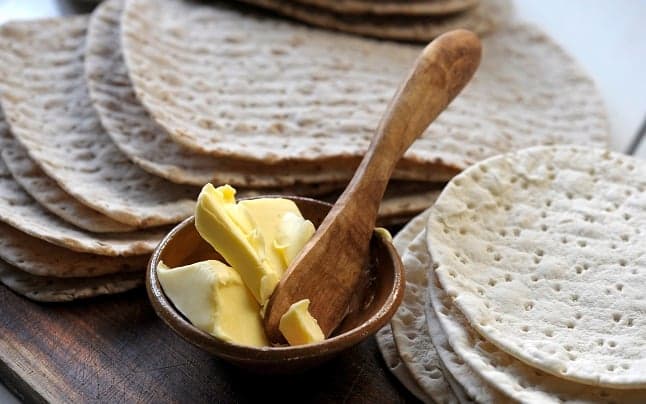Why do Swedes care so much about butter knives?

Have you ever wondered what's behind the Swedish fondness for the wooden butter knife?
Almost every Swedish households will have several of these in their cutlery drawer, and if you go to a souvenir shop you're bound to see plenty of them, perhaps with an elk or Viking decoration carved into the handle.
Dairy in general, including butter, plays a big part in the Swedish diet – although it only became really accessible to the majority after the Second World War – so the knife is often used to spread butter or Bregott (an oil-based spread) on crisp bread (knäckebröd) or open sandwiches (smörgåsar).
The Swedish butter knife (smörkniv) doesn't have a blade but is rounded for ease of spreading. So what is it that makes them such a beloved symbol of Swedish culture?
When I asked about the butter knife on Twitter, it was clear a lot of people have strong opinions. Some said that the use of wood rather than metal made it distinctly Swedish, and that it did the job better than other materials.
People from nearby countries, namely Finland, Norway and Estonia, jumped in to say they also have wooden butter knives – and that one reason they're so close to people's hearts is that it's a typical early woodwork or handicraft project in schools.
Probably origins from that all children are forced to make a pair in “träslöjden” and all parents are obliged to use them till end of time
— Andreas Lönnmo (@JarvsoLonnmo) May 22, 2021
Others agreed with me that the Swedes can't claim the butter knife as unique.
This looks just like the one my granny had, west of Ireland 1970s ish, and I doubt she had even heard of Sweden! Made of walnut..
And I'm pretty sure fika is just Swedish for tea break with scones! pic.twitter.com/FLRYks9Hqd
— paul geddes (@pdg1974) May 22, 2021
But maybe it's not the shape or material of the knife that makes it so Swedish, but rather the way it's used. The Local's writer Richard Orange argued that the Swedishness of the butter knife is the way one knife is used by everyone at the table (and that people who keep it on their plate are committing a huge faux pas). In that way, it shows the value placed on collectivism in Sweden.
Either way, it's not the only dairy utensil that there's a Nordic complex over.
Swedes can be equally protective of their cheese cutters (osthyvel), a tool for getting thin, even slices of cheese, and woe betide the person who uses them incorrectly, leaving a "ski slope" (skidbacke) in the cheese.
Comments (3)
See Also
Almost every Swedish households will have several of these in their cutlery drawer, and if you go to a souvenir shop you're bound to see plenty of them, perhaps with an elk or Viking decoration carved into the handle.
Dairy in general, including butter, plays a big part in the Swedish diet – although it only became really accessible to the majority after the Second World War – so the knife is often used to spread butter or Bregott (an oil-based spread) on crisp bread (knäckebröd) or open sandwiches (smörgåsar).
The Swedish butter knife (smörkniv) doesn't have a blade but is rounded for ease of spreading. So what is it that makes them such a beloved symbol of Swedish culture?
When I asked about the butter knife on Twitter, it was clear a lot of people have strong opinions. Some said that the use of wood rather than metal made it distinctly Swedish, and that it did the job better than other materials.
People from nearby countries, namely Finland, Norway and Estonia, jumped in to say they also have wooden butter knives – and that one reason they're so close to people's hearts is that it's a typical early woodwork or handicraft project in schools.
Probably origins from that all children are forced to make a pair in “träslöjden” and all parents are obliged to use them till end of time
— Andreas Lönnmo (@JarvsoLonnmo) May 22, 2021
Others agreed with me that the Swedes can't claim the butter knife as unique.
This looks just like the one my granny had, west of Ireland 1970s ish, and I doubt she had even heard of Sweden! Made of walnut..
— paul geddes (@pdg1974) May 22, 2021
And I'm pretty sure fika is just Swedish for tea break with scones! pic.twitter.com/FLRYks9Hqd
But maybe it's not the shape or material of the knife that makes it so Swedish, but rather the way it's used. The Local's writer Richard Orange argued that the Swedishness of the butter knife is the way one knife is used by everyone at the table (and that people who keep it on their plate are committing a huge faux pas). In that way, it shows the value placed on collectivism in Sweden.
Either way, it's not the only dairy utensil that there's a Nordic complex over.
Swedes can be equally protective of their cheese cutters (osthyvel), a tool for getting thin, even slices of cheese, and woe betide the person who uses them incorrectly, leaving a "ski slope" (skidbacke) in the cheese.
Join the conversation in our comments section below. Share your own views and experience and if you have a question or suggestion for our journalists then email us at [email protected].
Please keep comments civil, constructive and on topic – and make sure to read our terms of use before getting involved.
Please log in here to leave a comment.